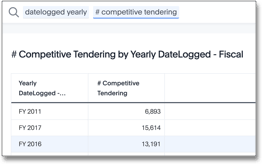Reaggregation Scenario 1: Supplier tendering by job
We have a fact table at a job or supplier tender response aggregation level. There are many rows for each job, where each row is a single row from a supplier. A competitive tender is a situation when multiple suppliers bid on the same job.
Our objective is to determine what percentage of jobs had more than 1 supplier response. We want to see high numbers, which indicate that many suppliers bid on the job, so we can select the best response.
Valid solution
A valid query that meets our objective may look something like this:
sum(group_aggregate(if(sum(# trades tendered ) > 1) then 1 else 0,
query_groups() + {claimid, packageid},
query_filters()))

Resolution
-
The
sum ( # trades tendered )function aggregates to these attributes:-
{claimid, packageid}The job-level identifier
-
query_groups( )Adds any additional columns in the search to this aggregation. Here, this is the
dateloggedcolumn at the yearly level. -
query_filters ( )Applies any filters entered in the search. Here, there are no filters.
-
-
For each row in this virtual table, the conditional
if() then elsefunction applies. So, if the sum of tendered responses is greater than 1, then the result returns 1, or else it returns 0. -
The outer function,
sum(), reaggregates the final output as a single row for eachdateloggedyearly value.-
This reaggregation is possible because the conditional statement is inside the
group_aggregatefunction. -
Rather than return a row for each
{claimid,packageid}, the function returns a single row fordatelogged yearly. -
The default aggregation setting does not reaggregate the result set.
-
Non-aggregated result
We include the following result to provide contrast to an example where ThoughtSpot does not reaggregate the result set.
Reaggregation requires the aggregate function, sum, to precede the group_aggregate function.
In the following scenario, the next statement is the conditional if clause.
Because of this, the overall expression does not reaggregate.
The returned result is a row for each {claimid,packageid}.
sum(if(group_aggregate (sum (# trades tendered),
query_groups() + {claimid, packageid},
query_filters ( ) )>1) then 1 else 0)




